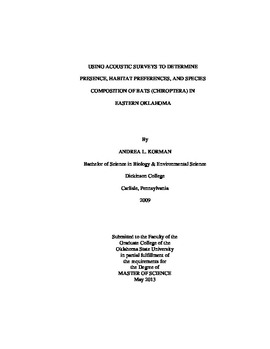| dc.contributor.advisor | McBee, Karen | |
| dc.contributor.author | Korman, Andrea Lynn | |
| dc.date.accessioned | 2014-09-24T14:18:07Z | |
| dc.date.available | 2014-09-24T14:18:07Z | |
| dc.date.issued | 2013-05-01 | |
| dc.identifier.uri | https://hdl.handle.net/11244/11101 | |
| dc.description.abstract | The purpose of this study was to gather baseline data on species composition and estimates of abundance in bat communities of eastern Oklahoma so that population changes can be monitored if White Nose Syndrome becomes established in these areas. This project also provides data concerning foraging habitat preferences of bats. My hypotheses were that more bat calls would be recorded in forested habitats than in agricultural or urbanized landscapes and that species composition would vary according to habitat type and location of survey route. Also, species such as the evening bat (Nycticeius humeralis), eastern red bat (Lasiurus borealis), and little brown bat (Myotis lucifugus) would make up the majority of the calls collected from each route because they are the most common species in this general area. Acoustic surveys and ArcGIS were used to assess habitat use and species composition across six 48 km (30-mile) transects over 3 years. Buffers with radii of 1 km and 2 km were used to analyze landcover associated with recorded bat call locations. Habitat types, bat abundance, and species composition were evaluated for each route to determine preferences and species diversity. For both the 1 km and 2 km buffers, forested habitat had significantly higher bat numbers than agriculture, development, or water. Of the six routes, Grand Lake and Tar Creek had significantly fewer bats overall and the Nickel Preserve had the greatest overall diversity. Perimyotis subflavus was the most frequently encountered species followed by Lasiurus borealis, Nycticeius humeralis, Myotis grisescens, Myotis lucifugus, Lasionycteris noctivagans, Eptesicus fuscus, Lasiurus cinereus, Corynorhinus townsendii, and Myotis septentionalis. These data suggest that diversity and abundance of bats are likely influenced by amount of forested habitat. This information can be useful in conservation efforts by identifying important areas regularly used by large numbers of bats and making them a priority for conservation, thereby helping maintain healthy bat populations and overall biodiversity of their environments. | |
| dc.format | application/pdf | |
| dc.language | en_US | |
| dc.publisher | Oklahoma State University | |
| dc.rights | Copyright is held by the author who has granted the Oklahoma State University Library the non-exclusive right to share this material in its institutional repository. Contact Digital Library Services at lib-dls@okstate.edu or 405-744-9161 for the permission policy on the use, reproduction or distribution of this material. | |
| dc.title | Using Acoustic Surveys to Determine Presence, Habitat Preferences, and Species Composition of Bats (Chiroptera) in Eastern Oklahoma | |
| dc.type | text | |
| dc.contributor.committeeMember | Baum, Kristen | |
| dc.contributor.committeeMember | Papes, Monica | |
| osu.filename | Korman_okstate_0664M_12753.pdf | |
| osu.accesstype | Open Access | |
| dc.description.department | Zoology | |
| dc.type.genre | Thesis | |
